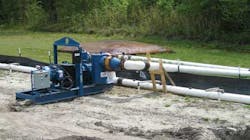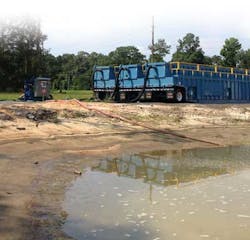Factoring for Filtration: Things to Consider When Dewatering Municipal Jobsites
By Lindsey Thorp
Dewatering is essential to the success of many jobsites and is particularly necessary when removing groundwater in order to safely perform certain tasks. As such, it's important to abide by applicable laws and regulations and to consider how the dewatering plan may impact the environment. Every location has its unique dewatering challenges, and it's crucial to consider all of the factors when designing an effective plan.
Careful attention should be paid to where water is being discharged and whether any filtering or processing will be required. The Environmental Protection Agency's (EPA) Clean Water Act (CWA) requires filtration of all water discharged into a navigable waterway. Some common methods of filtration often used in combination with pumps on jobsites include sediment tanks, filter bags and active treatment systems. Further, the quality of the water should be evaluated at the source to assess which filtration method would be ideal.
Before a pump can be selected for an application, the discharge flow rate and volume should be estimated. Trash pumps are most commonly used for dewatering on jobsites because they allow for solids to pass through without clogging the pump and can handle flows appropriately. As such, application engineers are often able to provide a pump application checklist to relay all of the pertinent information to the manufacturer who can help select the best pump for the job.
Wellpoint dewatering is the process of removing groundwater from soils in a localized area to accomplish the construction of a foundation, pipeline or any other belowground structure to perform soil remediation. Typical wellpoint dewatering applications include remediation of land, laying of deep sewer, water or utility lines, and excavations for building foundations. Wellpoint dewatering is common for shallow excavations in stratified soils and permeable sandy soils, and the system is often connected to a filter bag.
Filter bags are made of durable geotextile fabric that allows water to pass through while solids, such as sediments and other particles, remain trapped inside. The bag is attached to the discharge hose, and groundwater is pumped into it, trapping solids in suspension and allowing the sediment-free water to gently discharge into a nearby stream or other waterbody without polluting the waterway or causing erosion. The filter bag is full when it can no longer efficiently filter sediment or pass water at a reasonable rate, and its disposal should be directed by the site engineer. Capacity varies depending on the size of the filter bag.
A wellpoint system is used to remove water from the ground, which is then pumped into the weir tank where the solids are separated. The water is then passed to the stripping system, which extracts the pollutants, discharging clear and decontaminated water.
When a jobsite lacks sufficient space for larger filtration methods, a sediment tank is used to filter out solids. A sediment tank is a portable container separated into compartments by weirs. Water being removed from the location is pumped into one end of the container designed to allow the sediment-laden water to flow over and under a series of weirs, while unwanted materials fall to the bottom and clear water is discharged out the opposite end. This allows the water to be free of sediment before being discharged into a stream or storm drainage system. In instances where the groundwater contains contaminants such as oil or gas, further filtration is required through a stripping system.
Active treatment systems are used to regulate pH and reduce turbidity of water being removed from a jobsite to an acceptable level for discharge. One sand filtration system uses an agent called chitosan. Chitosan is derived from the shells of crustaceans and works as a natural coagulant, binding the sediment particles, heavy minerals and oils together and making it possible to remove them from the water.
Through this process, water is pumped from the source into a weir tank where chitosan is introduced to the water. The chitosan binds itself to the sediment particles, which become trapped in the sand filter, allowing only clear water to be discharged. Varying pH levels can cause extra wear on the pump; therefore, some manufacturers offer pumps with special materials such as bronze, stainless steel, or coated materials to prevent added wear. It is important to perform routine maintenance on pumps used in these types of applications.
Other less expensive and less technical methods of filtration can be installed, including vegetative buffers, silt fencing, berms, and retention basins. When discharging off-site is not an option, water will need to be retained on-site. Retained water is stored in tanks and is disposed of in several ways: it evaporates, it is infiltrated back into the soil, or it is reused on-site for dust control, irrigation or other purposes.
About the Author: Lindsey Thorp is the marketing manager for Thompson Pump, a full-service manufacturer and provider of heavy-duty portable pumps, pumping equipment and engineering expertise. She can be reached at [email protected]



